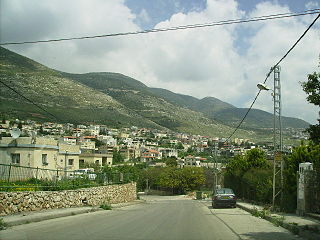
Al-Ruways, was a Palestinian Arab village on a rocky hill located 12 kilometers (7.5 mi) southeast of Acre and south of the village of al-Damun. Its population in 1945 was 330. Al-Ruways was depopulated following its capture by Israeli forces during the 1948 Arab-Israeli War.

Al-Kabri was a Palestinian Arab town in the Galilee located 12.5 kilometers (7.8 mi) northeast of Acre. It was captured by the Haganah 21 May 1948, a week after the State of Israel was declared. In 1945, it had a population of 1,530 and a total area cultivated of 20,617 dunams. It is near the site of Tel Kabri.

Tarbikha, was a Palestinian Arab village. It was located 27 kilometres northeast of Acre in the British Mandate District of Acre that was captured and depopulated by the Israel Defense Forces during the 1948 Arab-Israeli war. The inhabitants of this village were, similar to the inhabitants of Southern Lebanon, Shia Muslims.

Tamra is an Arab city in the North District of Israel located in the Lower Galilee 5 kilometres north of the city of Shefa-Amr and approximately 20 kilometres east of Acre. In 2022 it had a population of 35,834.

Al-Damun, was a Palestinian Arab village located 11.5 kilometres (7.1 mi) from the city of Acre that was depopulated during 1948 Arab-Israeli war. In 1945, the village had 1,310 inhabitants, most of whom were Muslim and the remainder Christians. Al-Damun bordered the al-Na'amin River, which the village's inhabitants used as a source of irrigation and drinking water from installed wells.
Joscelin III was the titular count of Edessa, who during his lifetime managed to amass enough land to establish a lordship in the Kingdom of Jerusalem.

The Kingdom of Jerusalem, one of the Crusader states that was created in 1099, was divided into a number of smaller seigneuries. According to the 13th-century jurist John of Ibelin, the four highest crown vassals in the kingdom proper were the count of Jaffa and Ascalon, the prince of Galilee, the lord of Sidon, and the lord of Oultrejordain.

Sajur is a Druze town in the Galilee region of northern Israel, with an area of 3,000 dunams (3 km2). It achieved recognition as an independent local council in 1992. In 2022 it had a population of 4,481.

Deir Hanna is a local council in the Northern District of Israel, located on the hills of the Lower Galilee, 23 kilometres (14 mi) southeast of Acre. In 2022 it had a population of 10,747. Approximately 90% of Deir Hanna's inhabitants are Arab Muslims and the remaining 10% are Arab Christians.

Mazra'a is an Arab village and local council in northern Israel, situated between Acre and Nahariyya east of the Coastal Highway that runs along the Mediterranean coast. The local council was founded in 1896 and was incorporated into the Matte Asher Regional Council in 1982, before proclaiming itself an independent local council again in 1996. In 2022 it had a population of 4,115.

Yarka, officially Yirka, is a Druze village and local council in the Northern District of Israel. In 2019 it had a population of 17,171, 98.8% of them members of the Druze community, with a small Muslim (1.0%) and Christian (0.1%) minorities.

Ga'aton is a kibbutz in northern Israel. Located in the western Galilee, it falls under the jurisdiction of Mateh Asher Regional Council. In 2022 it had a population of 725.

Mi'ilya, also called Mi'elya, is an Arab local council in the western Galilee in the Northern District of Israel. Its name during the Kingdom of Jerusalem era in Galilee was Castellum Regis. In 2022 it had a population of 3,281, all of whom are Melkite Greek Catholics. The town is located immediately to the northwest of Ma'alot-Tarshiha.
Juliana or Julianne Grenier was the Lady of Caesarea, which she inherited from her brother, Walter II, upon his death between 1189 and 1191. When she inherited the lordship, it had recently been conquered by Saladin, but in September 1192 it was restored to her rule by the Treaty of Jaffa. The city and its fortifications, however, were not rebuilt in her lifetime.
Margaret was the Lady of Caesarea. She was the eldest daughter and heiress of John of Caesarea and Alice de Montaigu, and both of her parents came from the upper echelons of the nobility of Outremer. Margaret was the second lady to inherit Caesarea, after her great-grandmother Juliana.

Beatrix de Courtenay was a Titular Countess of Edessa and Countess consort of Henneberg as the wife of Otto von Botenlauben. She was the eldest daughter of Agnes of Milly and Joscelin III, Count of Edessa, who sold Chastel Neuf and Toron to the Teutonic order. She was named after Joscelin’s mother.
Werner of Egisheim was a German Crusader, better known by his French name of Garnier l’Aleman.

Geoffroy de Donjon, also known as or Geoffroy de Duisson, was the eleventhth Grand Master of the Knights Hospitaller serving from 1193 through his death in 1202. He succeeded Garnier de Nablus who died in August 1192.
The House of Granier was a prominent noble family during the Crusades founded at the beginning of the 12th century by Eustachius Granarius, a Flemish nobleman from the Diocese of Thérouanne in the County of Saint-Pol who became lord of Sidon and Caesarea near 1110.
Tell Mulabbis is an archaeological mound in modern Petah Tikva, Israel.